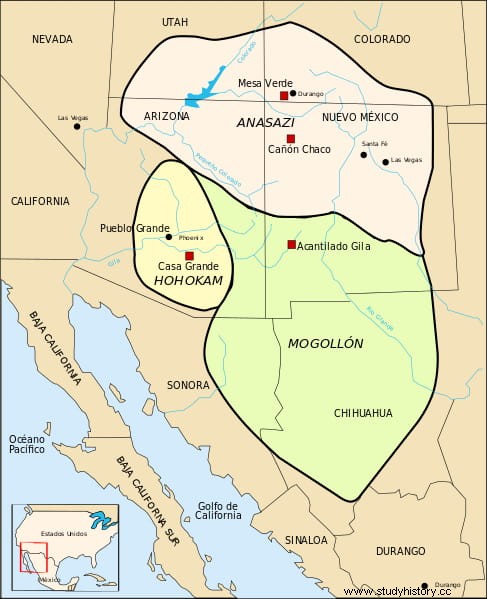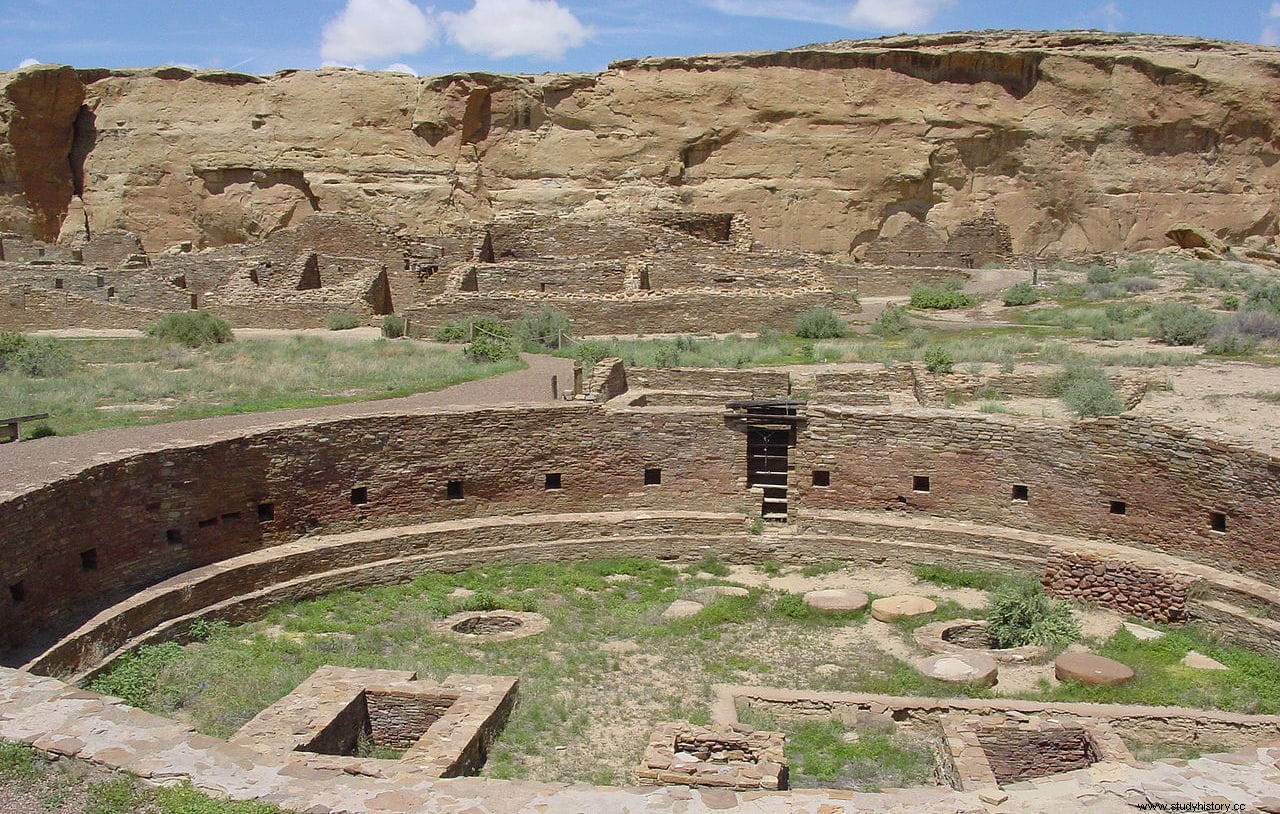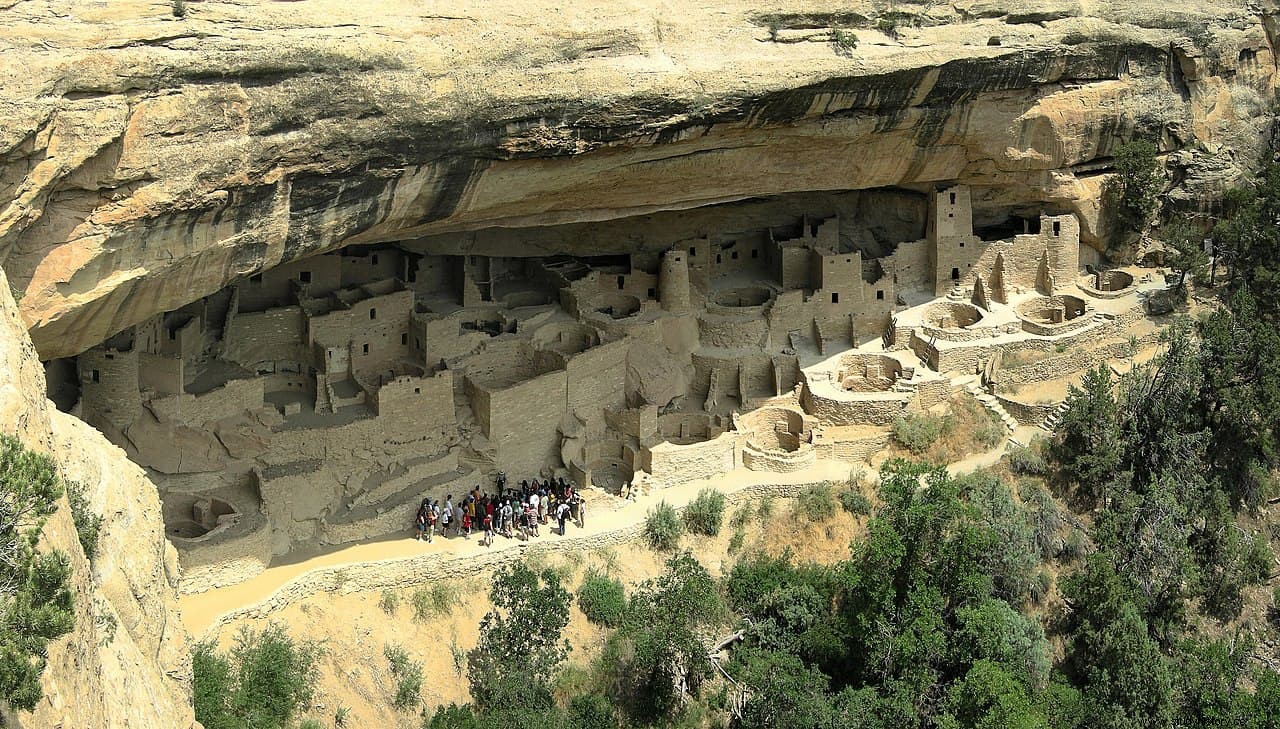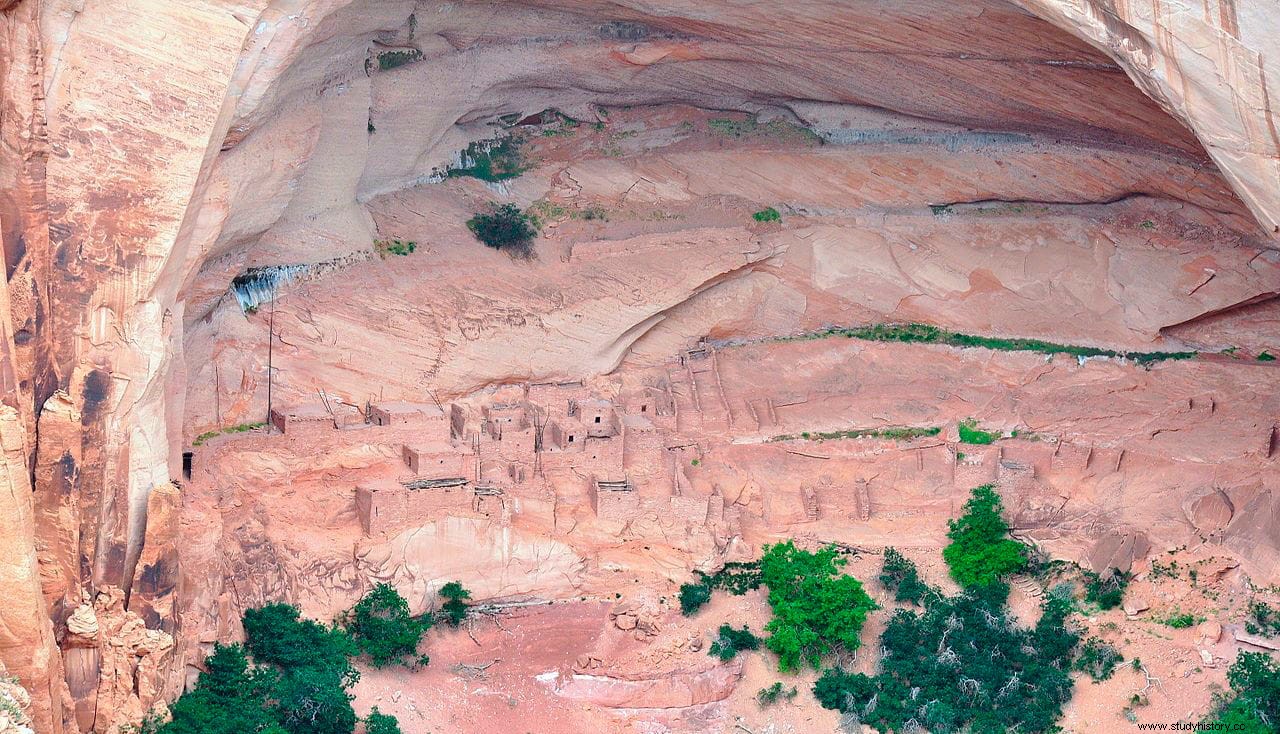As we saw in another article, the Naabeehó Bináhásdzo or Navajo Nation is the largest semi-autonomous territory in the United States; seventy-one thousand square kilometers distributed between Arizona, Utah and New Mexico, with its own government and administration and in which some sixteen thousand people live, mostly Navajo but also from other tribes. In its northern part there is an archaeological complex, made up of three groups of dwellings in natural shelters of a cliff, whose antiquity dates back to at least the 13th century. Listed for protection on the National Register of Historic Places in 1966, it is named Navajo National Monument (Navajo National Monument).
We recently dedicated an article to Oasisamerica, a term devised in 1954 by the German ethnologist and anthropologist Paul Kirchhoff to complement two others he had proposed earlier, Mesoamerica and Aridoamerica, referring in this case to a natural region located halfway between what is now the United States and Mexico. And we saw that the three great Oasis-American cultures were the Anasazi, the Hohokam and the Mogollón, with the Navajos falling into the first of them, recently renamed Ancestral Peoples. The Hopi, Zuñí Keres, Jemez or Tiwas, among others, must also be included there.
In reality, this differentiation becomes very complex because these tribes are traditionally grouped under the denomination of Pueblo Indians that the Spaniards gave it and, furthermore, from the aforementioned 13th century onwards, a confusing process of general decline and fusion developed that became even more complicated with the arrival of other groups such as the Shoshones. But the Anasazi are familiar above all because of their peculiar construction style, which is best represented in the Mesa Verde National Park, in the southwest of the state of Colorado, which we have also talked about here.

Inhabited since the 6th century, Mesa Verde was discovered and baptized by the Spanish twelve hundred years later, when they were looking for a route between California and Santa Fe. Its main characteristic is the same as that of Navajo National Monument:what is known as cliff dwelling , that is, houses located on cliffs, taking advantage of caves and shelters in the rocky walls (cliff houses ), well built on ledges (cavates ), accessed by wooden stairs or carved into the rock. They are settlements made up of several small houses, with hardly any openings and with the entrance on the roof, arranged around a circular plaza that was presumably intended for meetings and is called kiva .
Architecture of this type is found in the North American states of Utah, Arizona, New Mexico and Colorado, as well as in the Mexican state of Chihuahua (also in other places, such as the Chinese caves of Guyaju). In the case of Navajo National Monument, at the top of the Shonto plateau, which is part of a deep canyon called Tsegi (1,928 meters at its highest point), excavated by the Laguña Creek, a tributary of the Chinle Creek, which in turn it feeds the San Juan River (which flows into the Colorado).
Not far from there is Kayenta, the most populous town of the Navajo Nation with just under five thousand residents, whose hotels and restaurants serve as a tourist base to visit that interesting historical and natural environment (forty kilometers away is the famous Monument Valley, common in westerns by John Ford). Because, obviously, the place attracts many visitors and that is why it has two campsites, a network of trails, a viewpoint, guided routes...

Things must have been completely different in 1893, when four brothers dedicated to ranching, the Wetherills, arrived there. Their names were Richard, John, Al, and Win, and they didn't happen by chance, as Richard had discovered the Cliff Palace at Mesa Verde (a set of twenty-three kivas and 150 homes) five years earlier, while he was looking for some stray cattle accompanied by his brother-in-law, Charlie Mason, and a Ute guide, Acowitz, who was the one who told him about a site with old abandoned buildings.
Richard, born in Chester (Pennsylvania) in 1858, was a Quaker, like his family, with whom he moved first to Kansas and then to Colorado, settling in the Mancos River valley in 1880; there they founded the Alamo ranch. After the discovery of Mesa Verde, Richard, his brothers, and his father dedicated themselves to excavating the Cliff Palace, recovering numerous pieces that they sold to the Colorado Historical Society (they also offered them to the Smithsonian Institute, but the latter had no funds for acquisitions in that moment). They were soon joined by more onlookers.

One was the mountaineer Frederick H. Chapin, an amateur archaeologist who documented the site photographically, publishing a book entitled The Land of the Cliff-Dwellers; another, the Swedish Gustaf Nordenskiöld, son of a famous polar explorer, who had traveled to the US in search of fossils and in 1893 also published a work, The Cliff Dwellers of the Mesa Verde . Nordenskiöld ended badly with the Wetherills when they discovered that he was sending pieces to his country, something that transpired causing a wave of popular indignation and in 1906 would lead to the promulgation of the Antiquities Ac t, law that prohibited the removal of archaeological objects from US territory without permission.
Another consequence of the looting was the classification of Mesa Verde as a National Park that same year. There is a certain amount of irony in the fact that Nordenskiöld taught his American classmates scientific methodology, since they were nothing more than slightly more enlightened cowboys than normal. And it is that the Wetherills in general and Richard in particular (because he was the most dedicated to the cause) used to be underestimated and even ridiculed by the academic world... which did not prevent museums from buying their findings and hiring them for archaeological campaigns.
In fact, it was Richard who coined the term Anasazi (a Navajo word meaning "old enemy") and named what is now known as the Basket Makers culture. ), the oldest of the Ancestral Towns. It is understood that in 1893, after Mesa Verde, he decided to continue searching the Navajo Nation. For this, he had the help of his brothers and Frederick E. Hyde, a New York doctor who was fond of history and who provided funding. The beneficiary would be the American Museum of Natural History and their first discovery was Grand Gulch, in Utah, where they documented a collective burial.

But then Richard, his brother Al, and brother-in-law Charlie moved to Tsegi Canyon to dig what they named Keet Siel (Navajo for Broken Pottery), because there they got what Richard called "the best ceramic collection I've seen» . With one hundred and fifty rooms and six kivas , all well preserved thanks to the dry climate, it was an Anasazi settlement whose chronological dating is around 1250, experiencing a boom twenty-five years later (when it is estimated to have a hundred and a half inhabitants) for, after , decline and end up abandoned at the beginning of the fourteenth century.
The causes that led to the end of this sedentary lifestyle have not been fully clarified, although it is known that between 1276 and 1299 there was a sharp reduction in rainfall (the Great Drought) that prevented harvests. Likewise, the analyzes of the land show that the settlers tried to delve into it looking for or trying to channel water and the only thing they managed to do was spoil it. Given the impossibility of continuing to live from agriculture, they chose to emigrate. Something that the Hopi legends tell more poetically as a spiritual journey, in what could be interpreted as an exodus resulting from a clash between clans.

In 1896, the team excavated Pueblo Bonito, in Chaco Canyon, under the direction of a new member from the museum, George Pepper, who despite being a novice and did not like to work personally, relegated Richard. He took the opportunity to open a family store on site and little by little he expanded the business, which came to have a dozen stores and a store, selling Indian handicrafts. The protests of the academics for the alleged damage they produced in the deposits led to his expulsion from the expedition. But Richard was a man of means and took refuge in the Homestead Act to claim ownership of the land where the ruins were.
The Homestead Act o Rural Settlement Law was a law enacted by Lincoln in 1862 to encourage the arrival of European settlers, offering them land so that the national borders were extended to the West. For a symbolic price, any citizen could settle on a piece of land of little more than half a square kilometer with the conditions of remaining in it for at least five years, never having taken up arms against the country and being at least twenty-one years old or being the head of family, in addition to the obligation to build a house and work that land; he could then buy it with the proceeds from it.
One of the big problems with the Homestead Act was that often the land offered actually belonged to the Indians, and that was what happened in the Wetherhill case. His application was initially turned down, but in 1907 it was finally approved and Richard became the owner of nearly 150 acres which, following family tradition, he stocked with cattle. Unfortunately, he usurped the pastures of the Navajo sheep, with whom he had maintained a magnificent relationship until then (they called him amicably Anasazi and Marietta, his wife, Asdzani , that is, "Little Woman"), and a tense time arrived.

However, Richard ended up settling his differences with the natives, at least partially, and even invited a delegation of them to join the exhibit he set up at the 1905 St. Louis Fair. Two years later, in a show of goodwill , renounced his rights over the lands of the Chaco Canyon so that they could be classified as a National Park. That was not enough to forget all the quarrels and in 1910 he died at the hands of Chiishchilí Biye, a Navajo perhaps influenced by the Indian agent, whom Richard hindered in his plan for the civilization of the natives, many of whom were indebted to the Wetherhills. .
In 1909, his brother John had led an archaeological expedition at Rainbow Bridge, Utah; The team split into two groups, one of which, made up of John himself, University of Utah archaeologist Byron Cummings, and Indian guide Clatsozen Benullyh, worked to excavate a new Navajo Nation settlement the Hopi called Talastima ("Place of the Corn Kernel"), but better known today by its Anasazi name, Betatakin ("House built on a ledge"); dated between 1267 and 1286, it completes the Navajo National Monument.
Betatakin is not as big as Keet Seel, but it still had some one hundred and twenty sandstone dwellings built into a huge vaulted shelter of a sheer wall; there may have been more, since it is believed that there were some at the base of the mountain, outside the shelter, which have not been preserved as they are more exposed. In any case, of the others today only eighty remain, since a landslide has caused the loss of forty; there was also a singlekiva . Surely Richard would regret not being able to see it in person.
